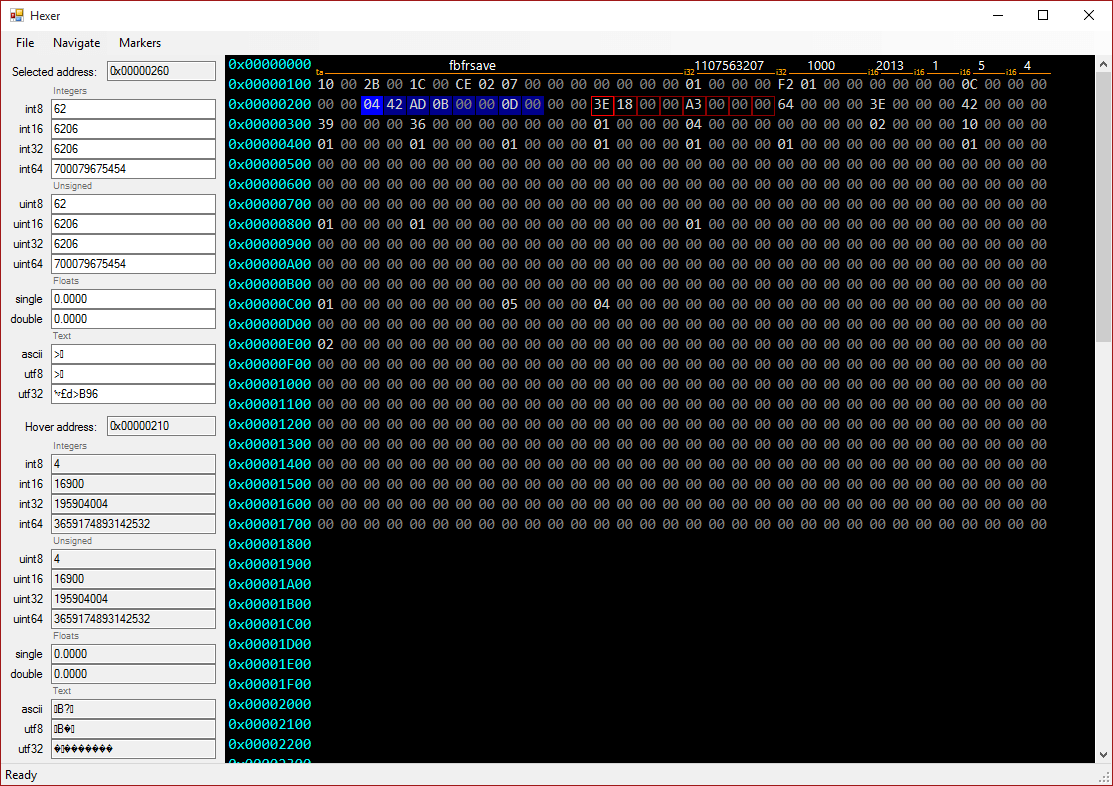
- #Binary editor how to 32 bit
- #Binary editor how to code
- #Binary editor how to free
- #Binary editor how to windows
#Binary editor how to code
The conversion should take no time - it may well take longer to download, start and setup Irfanview for the batch conversion.Īnyway, heres the code - you can chuck out all of the GDI+ stuff. I'd then run Irfanview on the folder, converting all of the BMP files to 32bit PNGs. Given that you have a desire to save them as PNG files, what I'd do would be to setup a small chunk of code that converted all of the binary files to BMP files.
#Binary editor how to windows
Windows Photo Viewer shows the transparent, black area as being black and opaque. Opening it with the Windows Photo Viewer makes it appear as though it's failed, however if I open it with GIMP, it's immediately apparent that the process has functioned as desired. I tried this on the output from a function that loads the binary file into a HBITMAP and found that the image was saved as expected.
#Binary editor how to 32 bit
Next I remembered some code that will save to a 32 bit BMP file. Unfortunately, GDI+ saved the colour values as desired, but set all of the alpha bits of the image to 255 - or opaque. I first tried to create the new image and then use GDI+ to save it as a PNG complete with 16 level transparency. I left a description of the file format in a comment above, though this can be seen from the code below. It's actually pretty easy, if one is vaguely familiar with image-based programming tasks. I'm a little lazy to look further into it at the moment, since I've a workable solution that doesn't require it. It seems that GDI+ isn't performing the way that I expect. Either that or create DIB section and draw the pixels yourself. Now that I think of it, you may want to use GDI+ to draw the pixels too, since GDI doesn't place so nicely with 32 bit bitmaps - especially when it comes to drawing pixels with an arbitrary alpha. I'd then use GDI+ to save the resultant HBITMAP as a png file. I'd then run through a loop of width*height iterations, where I: I'd then move the file-pointer to the position indicated by the ast member - the offset of the data. To read the file, I'd read the first 13 bytes into a struct. Therefore, it's safe to assume that the encoding format is 4 bits/channel ARGB format. This tells us that when these two bytes are read into a 16bit variable, the highest 4 bits wil be the alpha, the last 4 bits will be the blue. Remembering that the intel cpu is little-endian, we know that the first byte is the least significant, so we can swap the two bytes, giving 0xF8 0x87. If you then look at the 2 bytes at offset 0x7D, you can see the 2 bytes: 0x87 0xF8. In hex, this is 88,88,77,FF - As I mentioned earlier,each channel is only 4 bit, so simply disregard one of the nibbles of each value, giving you: 8,8,7,F. Now, if you then look at the pixel in the same image, we can check and see that it has the rgba value of 136,136,119,255. I.e 1/16 = 16/256 (I expect the disparity of 16/256 vs Gimps result of 17 is a simple math error - perhaps in the program that converted the original content into PNG, or the other way around, if thats the direction in which the data was converted. The 1 there corresponds to the alpha level of the pixel. If you then look at the 2 bytes at offset 0x3F, you get the values. If you have a look at the pixel using GIMP in the png image at, you can see that it has a colour of 0,0,0 and an opacity of 17.


That means you need 4 bits to describe the r, g or b channel of each pixel - with the remaining 4 bits being used to describe transparency. That is to say, there are only 16 different value for each of the RGB colour channels.

By converting it to an indexed image and checking out its palette, you can also see that when represented as a 24 bit image, each colour-channel has the identical high and low nibbles. You'd really need to look at a bunch of files to check the range of values found at offsets 0, 5 and 7.Ġxd - 2 * width * height - 16 bit pixel data.Īlso, if you look at the PNG, you can see that it uses transparency. Showing inserted/modified bytes is listed on the concepts page along with other features planned for future development.Looking at the 2 files, it seems reasonably clear to me what the basic format of the binary file is. Answer: Colourisation is currently what you described and it can't be configured yet. If I disable colourisation in the options, then all become white. But when I tested it, it seems that bytes smaller than 0x20 are purple, smaller than 80 are white, and others are teal, by default. More explanation for the colours? In the documentation, it seems to explain that colours mean inserted/modified bytes.
#Binary editor how to free
Free and open source binary/hexadecimal viewer/editor and component written in Java.Ĭomment from: User on Sunday 7th of November 2021 05:37:55 PM


 0 kommentar(er)
0 kommentar(er)
